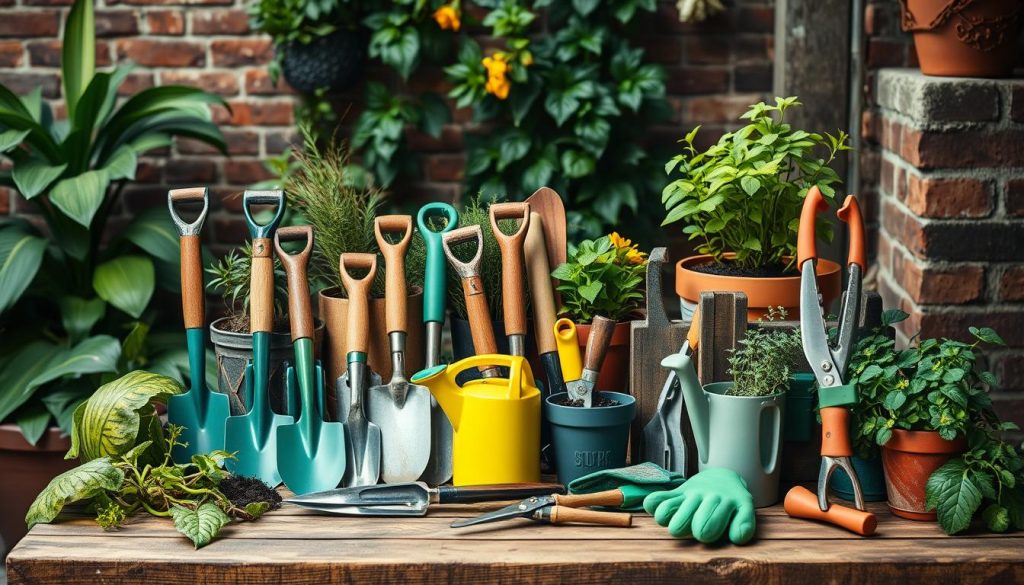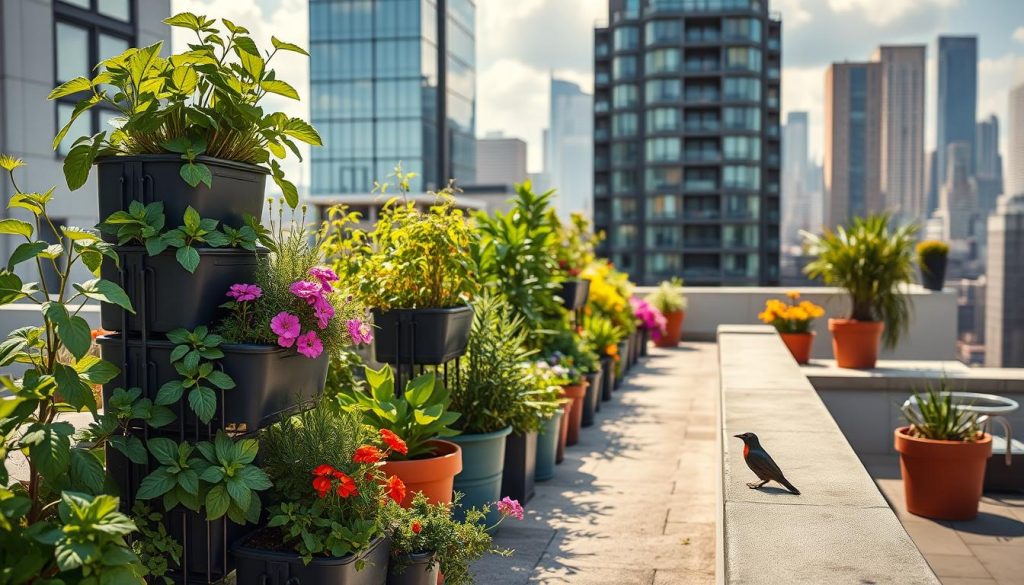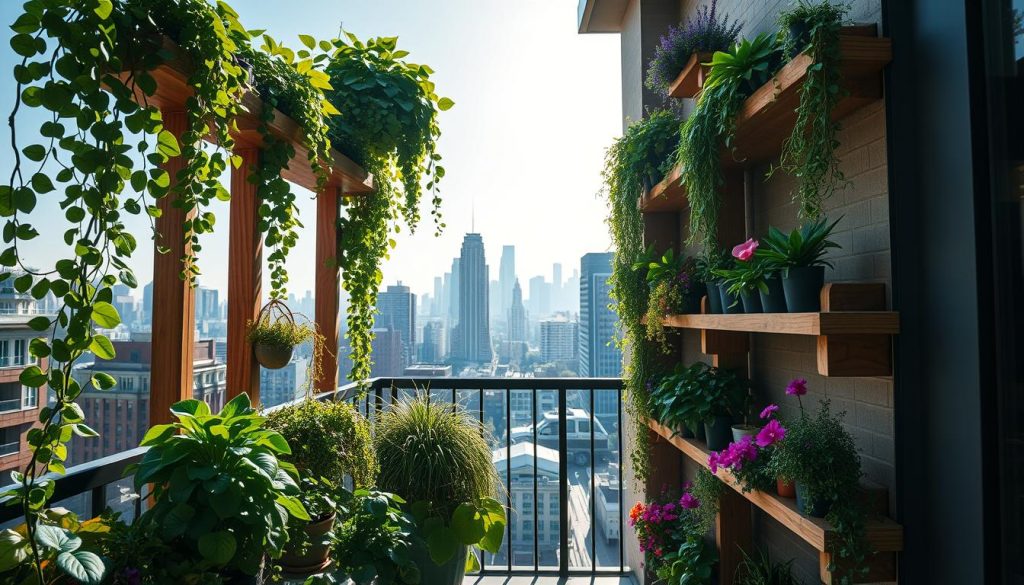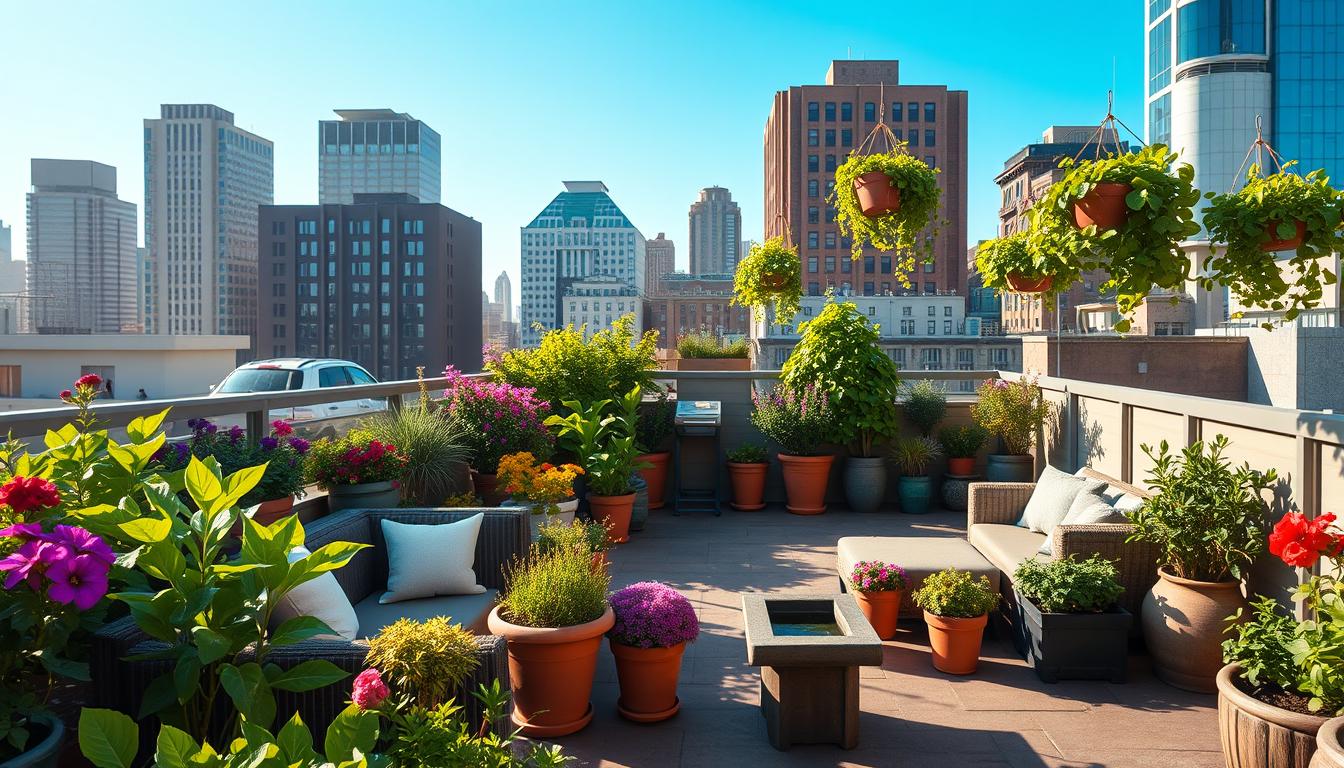I never thought I’d fall in love with gardening in the city. But here I am, with a lush green oasis on my tiny balcony. Urban gardening has become my passion, changing how I see my living space.
In cities across the United States, people are turning concrete jungles into vibrant gardens. A few plants can bring life to the smallest spaces. Urban gardening isn’t just a hobby; it’s a way to bring sustainable agriculture to our doorsteps.
My journey started with a single potted herb. Now, I’m growing vegetables, flowers, and even small fruit trees in my urban garden. It shows you don’t need a big yard to grow your own food and create a beautiful green space.
I’m excited to share my urban gardening adventure with you. Whether you have a windowsill, balcony, or small patio, you can create your own thriving oasis. Let’s explore how to transform your urban space into a green paradise!
What is Urban Gardening and Why I Love It
Urban gardening has changed my life, bringing nature to the city. It turns unused spaces into green spots. People like me grow plants in small areas, like balconies and rooftops.
My Journey into Urban Gardening
I began with a few herbs on my windowsill. As I grew more passionate, so did my garden. I added my balcony, using vertical planters and hanging baskets.
Benefits of Urban Gardening
Urban gardening has many benefits for me. It gives me fresh, organic food right at home. Taking care of my plants helps me relax and feel better mentally.
My garden also helps the city by cooling it down and improving air quality.
Common Misconceptions
Many think you need a lot of space or know-how for urban gardening. But it’s not true! Even a small spot can be a garden. With creativity and patience, anyone can enjoy gardening in the city.
| Misconception | Reality |
|---|---|
| Needs large space | Can be done in small areas |
| Requires expertise | Suitable for beginners |
| Time-consuming | Can be low-maintenance |
Choosing the Right Space for My Garden
Finding the perfect spot for my urban garden was key to success in edible landscaping. I learned that selecting the right space can make a big difference in plant growth and overall food security.
Assessing Sunlight and Shade
I started by watching how sunlight moved across my property. Some areas got full sun all day, while others had partial shade. This helped me decide where to plant sun-loving veggies and which spots were better for shade-tolerant herbs.
Considering Accessibility
Easy access was crucial for my urban garden. I chose spots near water sources and made sure I could reach my plants easily for watering, pruning, and harvesting. This setup made daily care much simpler and encouraged me to spend more time tending my edible landscape.
Indoor vs. Outdoor Gardening
I experimented with both indoor and outdoor gardening to maximize my food security efforts. Outdoor spaces allowed for larger plants and more variety. Indoor areas were great for year-round herbs and microgreens. By combining both, I created a diverse edible landscape that thrived in all seasons.
- Outdoor: Tomatoes, peppers, squash
- Indoor: Herbs, lettuce, sprouts
By carefully choosing my garden spaces, I’ve created a productive urban oasis that enhances both my home’s beauty and my family’s food security.
Essential Tools for Urban Gardening
Urban gardening is my passion. The right tools make a huge difference. Whether you’re working in community gardens or vertical farming, these essentials will help you succeed.
Must-Have Tools for Beginners
I began with a few key items. A strong trowel, pruning shears, and a watering can are must-haves. For vertical farming, a spray bottle is great for reaching high spots. And don’t forget gloves to protect your hands!

Caring for My Tools
Keeping my tools in good shape is crucial. I clean them after each use and store them dry. For metal tools, a light oil coat prevents rust. This keeps them ready for my next project.
Eco-Friendly Gardening Supplies
I’ve adopted sustainable practices in my gardening. I use biodegradable pots, organic fertilizers, and collect rainwater. For vertical farming, I make planters from recycled materials. These choices reduce my environmental impact while growing food.
- Biodegradable seed starters
- Compost bin for kitchen scraps
- Solar-powered garden lights
- Natural pest control solutions
With these tools and supplies, I’ve turned my urban space into a garden oasis. They’ve been invaluable in my community gardens and vertical farming. Urban gardening is both rewarding and sustainable with the right tools.
Selecting the Best Plants for Small Spaces
Urban gardening has changed my city life, especially with rooftop gardens. I’ve learned to use limited space well by picking the right plants. My small garden flourishes thanks to permaculture, which aims for sustainable ecosystems.
Top Plants for Limited Space
Here are some plants that do well in small areas:
- Herbs: Basil, mint, and thyme
- Leafy greens: Lettuce and spinach
- Compact vegetables: Cherry tomatoes and bush beans
- Vertical growers: Pole beans and cucumbers

Companion Planting Tips
Companion planting has made my garden more productive. I plant basil near tomatoes to enhance flavor and keep pests away. Marigolds help by repelling harmful insects. These strategies help me use space wisely and increase my garden’s yield.
Seasonal Planting Considerations
I change my plantings with the seasons to keep my garden active all year. In spring, I start with cool-weather crops like peas and lettuce. Summer brings in tomatoes and peppers that love the heat. Fall is for root vegetables and hardy greens. Even in winter, I grow microgreens indoors for a continuous harvest.
By choosing the right plants and using smart gardening methods, I’ve made a thriving urban oasis. Rooftop gardens and permaculture have changed how I garden in the city.
Container Gardening: My Go-To Solution
Container gardening has changed how I garden in the city. It lets me grow plants even in small spaces. This makes it great for urban gardening and sustainable farming.

Types of Containers I Use
I enjoy trying out various containers for my garden. Traditional pots work well, but I also like using old items. Things like wooden crates, hanging baskets, and vertical planters are part of my collection.
Each type has its own benefits for different plants and spots.
Soil Mixes for Container Gardens
Finding the right soil mix is key for container gardening. I look for something that’s light, drains well, and is full of nutrients. My favorite mix is a blend of potting soil, compost, and perlite.
This mix helps my plants grow well in their small spaces.
Watering Techniques for Containers
Watering container plants needs a bit more care than regular gardens. I’ve found a few ways to make sure they get the right amount of water. I check the soil moisture, use self-watering containers, and mulch the soil.
These methods save water and help my garden grow sustainably.
Vertical Gardening: Maximizing My Space
I’ve fallen in love with vertical farming in my urban horticulture journey. It’s a game-changer for small spaces. By growing up instead of out, I’ve transformed my tiny balcony into a lush garden oasis.
Benefits of Going Vertical
Vertical gardening has boosted my plant variety and yield. I can grow more in less space, which is perfect for urban living. It’s also improved air quality and created a natural privacy screen.

DIY Vertical Garden Ideas
I’ve tried several DIY vertical garden projects:
- Pallet gardens for herbs
- Hanging shoe organizers for succulents
- Trellises for climbing vegetables
- Stacked crates for flowers
These projects are fun, budget-friendly, and add a unique touch to my space.
Maintenance Tips for Vertical Gardens
Caring for my vertical garden is straightforward:
- Water frequently, as vertical gardens dry out faster
- Use lightweight potting mix for better drainage
- Prune regularly to maintain shape and health
- Check support structures often to ensure stability
With these tips, my vertical garden thrives year-round.
Sustainable Practices in Urban Gardening
Urban gardening is more than just growing plants. It’s about making green spaces that help the environment. I’ve learned a lot about growing food and reducing harm to nature.
Composting at Home
Composting is key in my garden. I make soil from kitchen waste and yard clippings. It cuts down on trash and gives my plants the nutrients they need.
Water Conservation Techniques
I’ve found ways to save water in my garden. I use rain barrels to collect water for my plants. Mulching keeps the soil moist, and drip irrigation waters the roots directly.
Integrated Pest Management Strategies
To fight pests without chemicals, I use natural methods. I plant flowers that attract good bugs, use row covers, and introduce ladybugs. These steps keep my garden balanced.
| Sustainable Practice | Benefits | Implementation in Green Spaces |
|---|---|---|
| Composting | Reduces waste, improves soil health | Kitchen scraps bin, outdoor compost pile |
| Water Conservation | Saves water, reduces utility costs | Rain barrels, mulching, drip irrigation |
| Pest Management | Eco-friendly, maintains biodiversity | Companion planting, physical barriers, beneficial insects |
These sustainable practices have made my garden a success. It’s not just about growing food. It’s about making a difference in our urban environment.
Troubleshooting Common Urban Gardening Problems
Urban gardening comes with its own set of challenges. I’ve faced many issues in my journey to boost food security through community gardens. Let’s explore some common problems and their solutions.
Dealing with Pests
Pests can be a big problem in urban gardens. I’ve found that natural remedies work best. Neem oil spray keeps aphids away. Copper tape around containers helps with slugs.
Recognizing Plant Diseases
Spotting diseases early is crucial. I check my plants daily for signs of trouble. Yellow leaves often mean overwatering.
Powdery mildew shows up as white spots on leaves. Quick action, like removing affected parts, can save your harvest.
Fixing Nutrient Deficiencies
Nutrient deficiencies can stunt plant growth. I’ve learned to read the signs. Pale leaves suggest nitrogen deficiency. Purple-tinged leaves point to phosphorus lack.
I use organic fertilizers to correct these issues. This ensures my community garden thrives.
| Problem | Signs | Solution |
|---|---|---|
| Aphids | Curled leaves, sticky residue | Neem oil spray |
| Powdery Mildew | White powder on leaves | Remove affected parts, improve air circulation |
| Nitrogen Deficiency | Pale, yellowing leaves | Apply organic nitrogen-rich fertilizer |
My Favorite Urban Gardening Resources
Urban gardening has become my passion. I’m excited to share the resources that have helped me grow. From books to online communities, there’s a wealth of knowledge out there for aspiring city gardeners.
Books That Inspired My Journey
“The Urban Farmer” by Curtis Stone and “Rooftop Growing Guide” by Annie Novak have inspired me. These books opened my eyes to the possibilities of urban gardening and rooftop gardens. They’re packed with practical tips and success stories that kept me motivated.
Online Communities and Forums
The internet is a goldmine for urban gardening advice. I love browsing Reddit’s r/UrbanGardening and the Urban Organic Gardener Facebook group. These communities are full of friendly folks sharing their experiences, from container gardening to vertical growing techniques.
Local Gardening Workshops and Events
Nothing beats hands-on learning. I’ve attended workshops at my local community garden and urban farming events in my city. These experiences have been invaluable in improving my urban gardening skills and connecting with like-minded green thumbs in my area.

